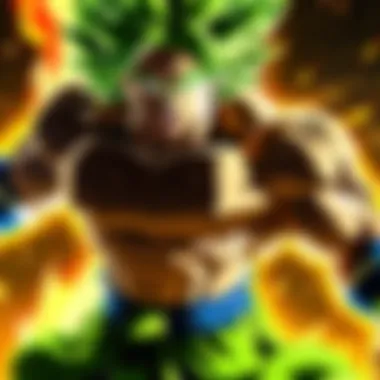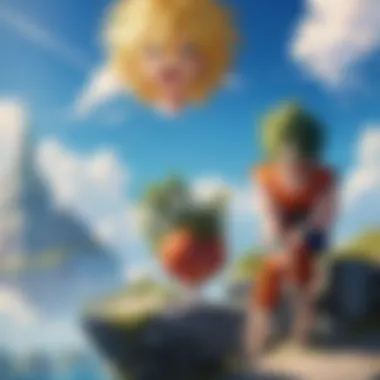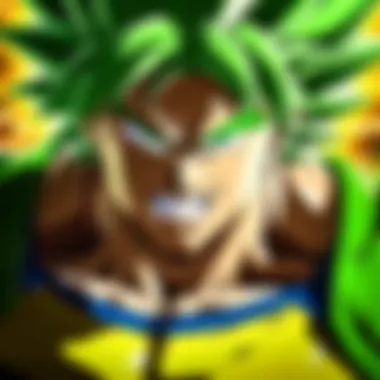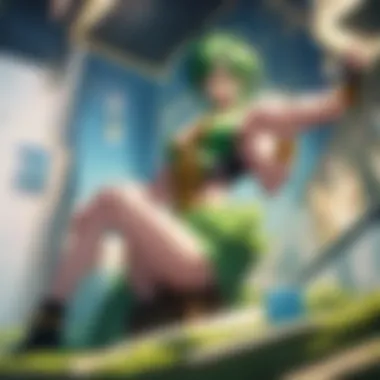Exploring the Depths of Dragon Ball Super: Broly


Intro
In the vast universe of anime, few franchises have managed to carve out a legacy like Dragon Ball. With its rich history and immense fanbase, the series has continually evolved to captivate audiences of every generation. Among its notable continuations and adaptations, Dragon Ball Super: Broly stands out as a significant entry, infusing new life into the narrative and extending the lore while simultaneously honoring its roots.
This film not only reintroduces fans to the mighty Saiyan warrior, Broly, but also weaves together fresh character arcs and a nuanced storyline that prompts viewers to reevaluate their understanding of the Dragon Ball canon. By dissecting the film’s narrative structure, character development, and distinct thematic elements, we aspire to illuminate how Dragon Ball Super: Broly fits into the broader tapestry of Dragon Ball lore, while simultaneously resonating with the culture of anime at large.
As we journey through this analysis, we will explore the film’s artistic style, discuss its major themes, and examine the cinematic techniques that elevate storytelling. So, let's dive into the heart of this engaging narrative, dissecting the many layers of Dragon Ball Super: Broly that make it a must-see not just for enthusiasts, but for anyone invested in the journey of these iconic characters.
Intro to Dragon Ball Super: Broly
The world of Dragon Ball has captured the hearts of fans for decades. As a pivotal part of this expansive universe, Dragon Ball Super: Broly stands as a cornerstone, reinvigorating the series while diving into rich narratives and complex character arcs. This introductory section lays the groundwork for exploring the film's distinct impact on the franchise.
Overview of the Dragon Ball Franchise
Dragon Ball originally reaches audiences as a manga series created by Akira Toriyama in 1984, quickly blossoming into a multimedia empire. It has seen multiple adaptations, spin-offs, and merchandise that reflect its cultural significance. The franchise uniquely intertwines themes of growth, adventure, and the eternal struggle between good and evil, resonating with fans worldwide.
As new generations discover Dragon Ball, the franchise's ability to adapt is evident. Each installment brings fresh stories while harmonizing with the established canon, effectively knitting together a tradition of epic battles and deep lore. This ability to shift and evolve is crucial as it captivates an audience that yearns for more than just flashy fights— the audience seeks depth and substance.
Significance of the Broly Character
Broly, first introduced in the 1993 film Dragon Ball Z: Broly – The Legendary Super Saiyan, had long been a fan-favorite. However, his character evolved over the years, often viewed through a lens of misunderstanding. Dragon Ball Super: Broly reintroduces him with a complex background, providing context and nuance that weren't present in earlier portrayals. In this iteration, Broly transforms from merely a destructive force to a figure grappling with sorrow and identity.
Understanding Broly's journey is important for fans and newcomers alike. It showcases how trauma can shape individual destinies while also reflecting themes of redemption and familial ties that are central to the Dragon Ball mythos. His character becomes a powerful lens through which to explore more profound questions of legacy and survival amidst chaos.
Transition from Canon to the Movie
The shift from the original Dragon Ball canon to a cinematic vehicle in Dragon Ball Super: Broly involves significant narrative liberties and creative storytelling techniques. By focusing on Broly's backstory and his connection to the Saiyan race, the film weaves inclusivity into established storylines, giving fresh energy to characters that fans have followed for years.
This transition marks an essential juncture in the series' storytelling. Rather than simply retelling older narratives, the film innovatively explores themes like exile and acceptance, breathing new life into the forgotten tales of the Saiyan heritage. This evolution indicates the creators’ willingness to honor the past while propelling the franchise into exciting new territories.
In summary, this introductory section not only emphasizes the importance of Dragon Ball Super: Broly as a pivotal film but also sets the stage for a deeper exploration of the narrative structure, themes, and character developments that follow. The foundation laid out here invites both die-hard fans and casual viewers to revisit their understanding of a beloved franchise, enriching their experience tenfold.
Plot Outline and Key Themes
The plot of Dragon Ball Super: Broly is not just a linear progression of events but a tapestry woven with complex themes and character relationships. Understanding the narrative structure makes it easier to appreciate not just the action-packed sequences but the underlying meanings that resonate with audiences. Themes of identity and redemption appear repeatedly and highlight Broly's journey, though viewers may often see only the surface-level battles.


The Narrative Structure
The narrative of Broly kicks off with the reintroduction of the Saiyan race’s lore. This backdrop is vital as it paves the way for Broly's character arc. The storytelling deftly zigzags between flashbacks and present-day confrontations, maintaining engagement while fleshing out the backstory.
- The film begins with King Vegeta's dismissal of Paragus's son Broly, setting the stage for themes of rejection.
- Following this, a switch to current events quickly builds tension as Goku and Vegeta are thrust into a battle against Broly, establishing stakes for both character sides and adding complexity into the plot.
By employing this dual-layered narrative, Broly illustrates how past experiences shape identity, particularly through trauma and its influence on choices the characters make.
Themes of Identity and Redemption
At the core of Dragon Ball Super: Broly lies a heartfelt exploration of identity. Each character grapples with their understanding of who they are, what they represent, and what they can become. Broly, for instance, is seen struggling between the weight of his Saiyan heritage and his inherent kindness. Goku and Vegeta's rivalry adds to the contrast, showcasing their individual journeys toward self-discovery.
- Identity: Broly's character transcends the rage-filled stereotype often pinned on him, revealing layers of vulnerability. His acceptance in the end signifies a profound step toward embracing his true self, which has often been overshadowed by familial expectations.
- Redemption: Paragus serves as a foil to this. His misguided protective instincts drive him towards manipulation and aggression. However, Broly’s resolution allows for a redemption arc that challenges Paragus’s motivations, presenting a poignant example of how one can confront their past and seek change.
The Importance of Legacy
Legacy plays a pivotal role as well. Throughout Dragon Ball Super: Broly, the question of how one's history affects their future looms large. The Saiyan legacy is fraught with turmoil and conflict, yet it is portrayed in a way that offers hope for transformation.
- Broly's story reminds viewers that one’s lineage does not have to dictate their fate. His struggle against expectations presents a nuanced examination of what it means to be a Saiyan in a more compassionate light.
- Goku and Vegeta also embody this notion. They carry their legacies but choose to forge new paths, one where benevolence overcomes the brutal past of their race.
"The struggle between past and future is what shapes our legacy, and it is never too late to redefine it."
In summary, the plot outline of Dragon Ball Super: Broly is not simply about epic battles but dives deep into identity, redemption, and the importance of legacy. These intertwined themes serve to enhance the emotional resonance of the narrative, bridging the gap between characters and providing audiences with relatable aspects of the human experience in a fantastical setting.
Character Development in Broly
In the realm of anime, character development stands as a cornerstone of storytelling, shaping viewer engagement and emotional connection. In Dragon Ball Super: Broly, character dynamics are pivotal, particularly in the exploration of emotional depth and social interactions. This film not only revives a formidable character but also deepens the understanding of interpersonal relationships within the Dragon Ball universe. Such development invites viewers to reevaluate established notions of heroism and villainy, emphasizing that characters are not simply good or evil, but often shaped by their environments and experiences.
Broly: A Complex Protagonist
Broly emerges as a character rich in intricacies. Born with prodigious strength, his journey reflects the struggles that come with immense power weighed down by a tragic past. Unlike traditional portrayals of antagonists in anime — who often exhibit overt malevolence — Broly’s narrative unveils layers of vulnerability and rage stemming from deep-seated trauma.
His relationship with Paragus, his father, is a double-edged sword. Paragus's ambition to harness Broly's power creates a toxic bond that complicates Broly's self-identity. Viewers can empathize with Broly's plight as he oscillates between a protective instinct and the rage that leads to destruction. This portrayal is a departure from mere brute force, underscoring how a character can be both a victim and a source of chaos simultaneously.
Goku and Vegeta: Evolution of Rivalry
The relationship between Goku and Vegeta has changed significantly throughout the series, and in Dragon Ball Super: Broly, this evolution manifests in surprising ways. Initially rooted in antagonism, their rivalry has matured into a connection based on mutual respect. They now find common ground in their recognition of Broly's true nature.


What’s fascinating here is how their rivalry serves as a lens to reflect on their character growth. Both Saiyans experience a reluctant recognition of the consequences of their actions on Broly, prompting introspection regarding their own paths. Their journey through rivalry to collaboration offers a fresh perspective—showcasing that strength isn’t solely derived from fighting prowess but also from understanding and acceptance.
Paragus and the Father-Son Dynamic
The relationship between Paragus and Broly illustrates profound facets of familial influence. Paragus embodies the archetype of an overbearing parent, pushing his son's limits without regard for emotional ramifications. His authoritarian demeanor forges a relationship built on fear and resentment, effectively acting as an antagonist in Broly's narrative arc.
This father-son dynamic encapsulates a critical theme: how parental expectations can distort a child’s identity. The portrayal of Broly's struggle against Paragus's oppressive nature raises poignant questions about freedom, choice, and the burden of legacy. As Broly seeks to break free from his father's shadow, viewers are compelled to reflect on the broader implications of control in family relationships.
"Character arcs not only reveal personal struggles but serve as mirrors reflecting the social dynamics that shape our lives."
Within Dragon Ball Super: Broly, these character developments intertwine, offering rich commentary on personal growth and the multifaceted nature of relationships. It emphasizes that true strength lies in knowing oneself and one’s place in a complex web of connections.
Visual and Cinematic Techniques
The world of Dragon Ball Super: Broly is not merely animated; it’s a feast for the eyes, employing visual elements that resonate with audiences on multiple levels. This section explores the various techniques used in the film, showcasing how animation, color, and sound come together to create a lasting impression on viewers. Understanding these elements can deepen appreciation for the storytelling and thematic layers embedded within the film.
Animation Style and Its Impact
The animation style found in Dragon Ball Super: Broly stands out for its dynamic fluidity and meticulous detail. Unlike its predecessors, the film employs a unique blend of traditional and digital animation techniques. This hybrid approach allows for more expressive character movements and vivid action scenes. The intense battle sequences, particularly between Goku, Vegeta, and Broly, are animated to near perfection, making every punch and kick feel impactful. Fans have noted how the crispness of the action entwines with the emotional stakes of the characters, enhancing the thrill of each encounter.
For example, during the climactic fight, the animation fluidly transitions from slow-motion to rapid sequences, capturing the heightened sense of urgency. This not only elevates the stakes but also invites viewers to become emotionally invested in the characters' fates.
Color Palette and Symbolism
The color palette of Broly is deliberately crafted, serving both to enhance visual appeal and to convey deeper meaning. A vibrant mix of hues – ranging from the blazing reds and oranges of battle scenes to the serene blues of emotional moments – creates a landscape where every shade has significance. For instance, Broly’s transformation into a Super Saiyan is accompanied by an explosion of greens and yellows, symbolizing his raw power and untamed spirit.
Unlike more muted palettes often seen in darker anime, the choices in Broly reflect its underlying themes of conflict and redemption. The stark contrasts convey not just the physical battles, but also the internal struggles faced by the characters.
"Color is not just decoration; it speaks to the essence of the characters and their journeys."
This synergy between color and narrative offers a rich vein of interpretation for fans seeking to understand the emotional layers of the story.
Sound Design and Score
While visual aspects are crucial, the auditory experience in Dragon Ball Super: Broly plays an equally vital role. The sound design skillfully incorporates the sounds of battle, the subtle grunts and gasps of tension, and the orchestral score that underscores key moments. A standout feature is the music by Norihito Sumitomo, which escalates the emotional weight of scenes. The score shifts seamlessly from gripping orchestral pieces during fights to more intimate melodies during character-driven moments.
These audio elements work in tandem with the visuals to create an immersive experience. For example, in a tender moment between Goku and Vegeta reminiscing about their past, the score softens as the colors become warmer, guiding the viewer's emotional responses.


In sum, the nuanced sound design enriches the narrative, providing both context and tension. It proves that just as important as what is seen on screen is what is heard, and together they amplify the storytelling of Dragon Ball Super: Broly.
Cultural and Social Impact
The cultural and social impact of Dragon Ball Super: Broly extends far beyond its impressive animation and thrilling battles. This film has catalyzed conversations surrounding identity, belonging, and redemption among fans and critics alike. It is essential to examine how this cinematic piece fits into the broader cultural tapestry of anime and its influence on global pop culture, especially when viewed through the lens of its fanbase's reactions, Broly's role in various narratives, and thematic comparisons with other cinematic offerings.
Reception Among Fans
The reception of Dragon Ball Super: Broly among fans has been nothing short of monumental. When it was released, many viewers took to social media platforms to express their excitement, feelings of nostalgia, and their reactions to the newly revamped Broly character. Many noted how the film beautifully interwove elements from previous Dragon Ball iterations while maintaining fresh, new character arcs.
- Nostalgia Factor: Long-time fans appreciated the return of Broly, a character they had loved since the earlier movies, albeit with a much deeper and richer backstory.
- Community Engagement: Forums and subreddits lit up with discussion, theories, and analyses almost immediately after its release. Places like reddit.com became hubs for fans voicing their opinions.
- Critical Acclaim: Through the lens of various review aggregators, the film has garnered generally favorable reviews, highlighting its animation quality and character development, which has built a bridge connecting both new viewers and seasoned fans.
Broly's Influence on Pop Culture
In the grander scheme of pop culture, Broly’s reintroduction has proven pivotal. This film reconfigured not just how we view Broly himself, but also what he represents in the larger Dragon Ball universe and beyond. For many, he embodies the idea of overcoming adversity, reflecting the struggles many face in their everyday lives.
- Merchandising: The renewed interest in Broly spurred a wave of merchandise from figures to clothing, as fans sought to celebrate their connection to this complex character.
- Crossover Appeal: Broly’s character reached beyond Dragon Ball, inviting comparisons to figures in other media, such as Marvel’s Hulk, which emphasizes brute strength mixed with vulnerability. This crossover appeal amplifies the conversation about influence across genres.
- Inspirational Role: In various interviews, creators have mentioned how Broly's themes resonate with narratives around mental health and finding identity, making him a symbol for discussions on those crucial matters.
Comparative Analysis with Other Films
The cinematic landscape is crowded and diverse, but Dragon Ball Super: Broly has carved its niche by differentiating itself through both narrative depth and visual artistry. When compared to other films, especially within the anime medium, it stands out for a few reasons:
- Animation Quality: When juxtaposed with similar films like My Hero Academia: Two Heroes, Broly showcases an animation style that feels more fluid and dynamic, presenting battles that retain both impact and elegance.
- Theme Exploration: While both films touch on themes of heroism and self-discovery, Broly’s journey deeply examines the effects of emotional scars and environment on one's identity, which feels more nuanced in comparison.
- Cultural Relevance: Unlike typical narratives that focus mainly on action, Broly attempts to anchor its storyline in relevant social themes such as belonging and acceptance, which resonate broadly with today's audiences.
In sum, Dragon Ball Super: Broly represents a phenomenal blend of nostalgia, emotional depth, and significant cultural resonance, showcasing the impact of anime to a global audience. Viewers are not only entertained but are also presented with themes that provoke thought and discussion, firmly establishing the film’s position not just in anime culture but in global pop society.
Finale
In the world of anime, few franchises have left as notable a mark as Dragon Ball, and Dragon Ball Super: Broly stands as a testament to its enduring legacy. As we wrap up this exploration, it's essential to reflect on how this film has not only redefined a beloved character but also contributed profound nuances to the Dragon Ball mythos.
Broly's Place in Dragon Ball Lore
Broly is no longer just a powerful fighter; he’s been reimagined with layers of drama and depth that resonate with fans of all generations. His evolution from a mere antagonist steeped in rage to a more relatable figure highlights significant themes such as identity, acceptance, and redemption. With Broly's background explored, audiences grasp the complexity behind his character, which extends beyond sheer power. Several aspects highlight his position in the Dragon Ball lore:
- Reinterpretation of Origin: The flick delves into Broly’s traumatic past, establishing stronger ties to other key figures in the series, particularly Goku and Vegeta.
- Rivals, Not Enemies: The narrative reframes Broly’s relationship with Goku and Vegeta, steering away from a traditional hero–villain dichotomy to a more nuanced understanding of rivalries.
- Legacy of Saiyans: Through Broly, the film also enhances the importance of Saiyan heritage and its implications on personal and collective identities.
In essence, Broly's character embodies the struggles faced by those cast aside by their past, making him a compelling figure within the Dragon Ball tapestry.
Future Implications for the Franchise
Looking ahead, Dragon Ball Super: Broly opens the door to numerous possibilities in the franchise. Several factors can influence the direction the series might take:
- Expanded Universe: With the introduction of Broly, creators have the option to further explore the Saiyan race and their history. This could lead to new characters or even delve into long-standing mysteries within the lore.
- Character Development: Broly’s character arc can be further expanded in potential sequels or series chapters, enriching the narrative while allowing for character growth.
- Diverse Storylines: As the franchise continues to grow, incorporating alternate storylines that challenge existing characters offers fans new perspectives while keeping the essence of Dragon Ball intact.



